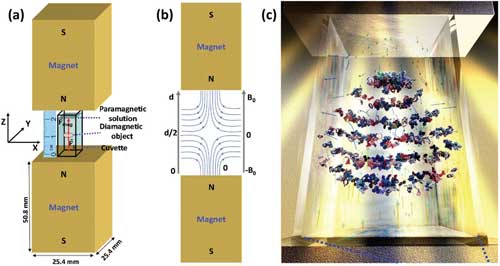| Feb 03, 2020 | |
Detecting diseases with magnetically levitated plasma proteins |
|
| (Nanowerk Spotlight) Proteins present in human plasma mirror a person's physiology and the ability to rapidly profile the plasma proteome holds the promise of a revolution in point-of-care disease diagnosis and therapeutic monitoring. | |
| Existing techniques such as enzyme-linked immunosorbent assay and liquid chromatography mass spectroscopy already use human plasma to detect a variety of possible diseases. Now, researchers have used magnetic levitation (Maglev) as a new approach to analyze plasma proteins. | |
| In a previous Nanowerk Spotlight ("Magnetically levitating proteins to precisely measure their density") we reported that the MagLev technique may provide useful insights into the measurement of the density of proteins in solution for better understanding the physicochemical properties of proteins. | |
| New findings, reported in Advanced Healthcare Materials ("Evolving Magnetically Levitated Plasma Proteins Detects Opioid Use Disorder as a Model Disease"), suggest that levitation patterns of human plasma proteins using the MagLev technique may provide useful information about the health spectrum of individual donors. | |
| "Since different diseases produce substantial variations in the plasma proteome, we hypothesized that the levitation progress and patterns of plasma proteins may hold some information on an individual's health conditions," Morteza Mahmoudi, an Assistant Professor in the Precision Health Program at Michigan State University, tells Nanowerk. | |
 |
|
| a) Schematic representation of the Maglev device configuration used in this study; b) distances and gradient of magnetic field between two permanent magnets; c) demonstration of levitation pattern of human plasma proteins in superparamagnetic iron oxide nanoparticles solution. (Reprinted with permission by Wiley VCH Verlag) (click on image to enlarge) | |
| Mahmoudi, who led this work, says that this new study revealed that optical images of magnetically levitated plasma proteins carry important information about the health spectrum of plasma donors. | |
| "We have studied the optical images of 8 healthy individuals and 9 opioid used disorder (OUD) patients plasma donors, obtained from our Maglev system," he notes. "Based on the results, we developed a classification and prediction model to determine whether examination of levitated plasma proteins in the Maglev system can provide 'fingerprints' to differentiate between healthy individuals and OUD patients." | |
| By comparing the levitation profiles of plasma proteins of healthy people to that of people with OUD disease the team found distinct and reliable differences in the health spectrum of plasma proteins of healthy individuals and those with OUD. This might be related to the known interactions of opioid drugs with plasma proteins, which in turn could affect their levitation characteristics. | |
| The researchers also found that the top 20% most abundant proteins were hemoglobin subunit alpha, beta, and delta as well as Apolipoprotein C-II, which were only found in the OUD levitated plasma protein bands. | |
| According to Mahmoudi, in addition to high abundant proteins, the results showed that the levitated bands of OUD samples contained much more of the rare proteins when compared to their counterpart bands in healthy samples. | |
| The researchers suggest that a simple portable MagLev device could provide diagnostic value for disease detection using optical images of evolving magnetically levitated plasma proteins and/or proteomic information. | |
| Consequently, they are planning to use the MagLev technique to identify other types of chronic diseases, like multiple sclerosis (MS) and cancer, where accurate diagnosis is critical, and in many cases life-saving. | |
| "Correctly diagnosing the type of MS is critical, since it dictates which type of treatment is appropriate," Mahmoudi points out. "We hope MagLev device will give clinicians a technique to define the subtypes of MS diseases." | |
| Since MagLev is a method that works based on the differences of the density of the materials, it is an ideal technique for the separation of materials. In addition, MagLev is a robust and highly reproducible technique to solve a broad range of problems in physics, chemistry, engineering, and biology, including analysis of food and water, quality control of materials, diagnosis, kinetics of chemical reactions, self-assembly, and separation of materials from mixtures. | |
| For their next steps, the team plans to miniaturize the MagLev system towards portable point-of-care devices for rapid disease detection. They also will have to address to crucial limitations of the current device design: | |
| A constraint that causes prohibitively long times of separation due to Brownian motion is the time required for levitation – which is closely related to the size of the diamagnetic materials used. This time and size limitation can prevent the practical use of MagLev for many applications (e.g., point of care diagnosis, biological and biochemical substances, and multistep procedures) in which short-time separations of submicrometer objects are essential. | |
| The other problem of the use of MagLev in biological/biomedical applications is the toxicity or incompatibility of the current paramagnetic solutions (e.g., GdCl3, MnCl2, and MnBr2) to the biological systems. | |
 By
Michael
Berger
– Michael is author of three books by the Royal Society of Chemistry:
Nano-Society: Pushing the Boundaries of Technology,
Nanotechnology: The Future is Tiny, and
Nanoengineering: The Skills and Tools Making Technology Invisible
Copyright ©
Nanowerk LLC
By
Michael
Berger
– Michael is author of three books by the Royal Society of Chemistry:
Nano-Society: Pushing the Boundaries of Technology,
Nanotechnology: The Future is Tiny, and
Nanoengineering: The Skills and Tools Making Technology Invisible
Copyright ©
Nanowerk LLC
|
|
|
Become a Spotlight guest author! Join our large and growing group of guest contributors. Have you just published a scientific paper or have other exciting developments to share with the nanotechnology community? Here is how to publish on nanowerk.com. |
|
